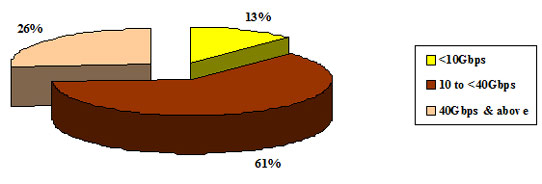Global consumption of external modulators in optical fiber communication networks is projected to reach $229m in 2013, according to market research firm ElectroniCast Consultants in a new forecast and analysis.
There are essentially two ways to modulate laser diodes: directly and indirectly (externally). In the new research study, ElectroniCast provides a market forecast of the use of electro-optic (E-O) and electro-absorption (EA) modulators.
Consumption (use) of electro-optical (E-O) modulators is set to maintain market leadership over electro-absorption (EA) modulators throughout the forecast period (2013-2018), reckons ElectroniCast.
The report details optical modulator use for the following transfer rate categories: less than 10Gbps; 10Gbps to less than 40Gbps; 40Gbps and higher.

Graphic: Projected external optical modulator market share by bit-rate (in consumption value, as a percentage of $229m in 2013), showing the 10 to <40Gbps category leading.
According to the study, the use of modulators with optical communication transmitters at rates of 10Gbps and higher (but under 40Gbps) is forecast to maintain the lead in relative market share throughout 2013-2018. However, the 40Gbps (and higher) category is forecast to increase at a faster annual pace and set to nearly catch-up in market share. "The dramatic push for faster bit-rates and extended connectivity of data centers, residential, mobile smartphones, and smart network communications will eventually drive networks to incorporate optical interfaces beyond 100G," notes Stephen Montgomery, director of the Fiber Optics Component Group at ElectroniCast.





